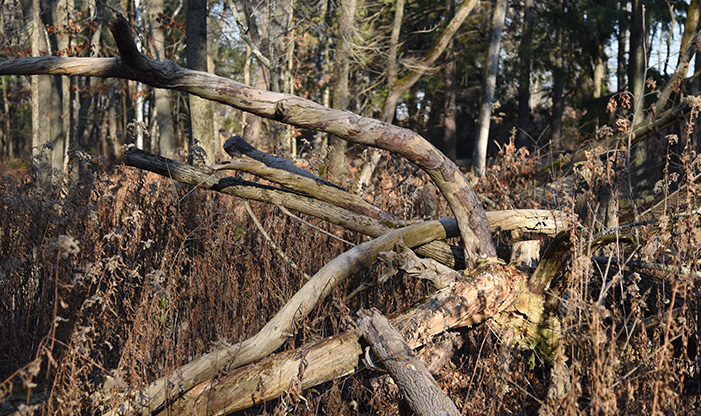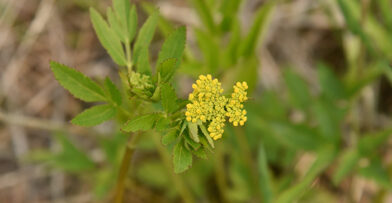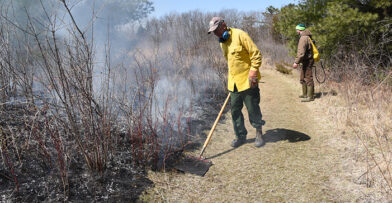When visitors hike our Central Wetlands Loop, Elizabeth Trail, and our other forested areas, you may notice some fallen trees laying on the ground. There’s a good reason for these trees to be there. Collectively, they are termed coarse woody habitat, and they provide an essential service to the surrounding ecosystem.
Coarse woody habitat consists of a fallen tree with or without branches, left on the ground to decay over time. The tree can be beneficial anywhere it falls, such as in the prairie or woods, and serves an important role to numerous species of flora and fauna.
Habitat for Mammals, Birds, and Amphibians
In a fallen tree, there is space for nests, dens, and burrows. Mammals use fallen trees for shelter as they provide cover for predators and protective cover for prey. Chipmunks, raccoons, and mink find homes in the hollowed-out section of the trunk. Underneath the log, amphibians will thrive, including salamanders and frogs. Woodpeckers make nest cavities in the logs, and birds that are low-level nesters find shelter there.
Coarse woody habitat provides nutrition to many species. Insects eat the dead tree, and in turn become food for birds. Woodpeckers eat ants, which form colonies and are important for adding organic matter to soil. Resident and migrating birds benefit from having the insects as a food source.
Nutrition for Wildlife and the Forest
Decaying wood provides organic matter to the soil, which is important for regeneration of forest. Dead wood, like all living organisms, also releases nitrogen and phosphorus, essential nutrients that act as fertilizer. Nitrogen-fixing bacteria aid in the tree’s release of additional nitrogen to the soil. Some fungi rely solely on the fallen log to grow. Fungi digest the decaying tree’s nutrients, and release them to soil when they die, fall off the log, and decompose. Lichen, which are a species of fungi and blue-green algae living in a symbiotic relationship, thrive on fallen trees and add nutrients to the soil.
Stormwater Retention
Coarse woody habitat is an important tool for stormwater retention. It’s one of the big reasons our conservation team leaves fallen trees on the ground. A fallen tree absorbs 250% of its weight in water, reducing the amount of water flowing on the ground during heavy rain. This stabilizes the soil and helps to prevent erosion caused by stormwater runoff. Many of the fallen trees in the North Ravine accomplish this, working in conjunction with the system put in place for our Stormwater Wetland & Ravine Restoration Project.
Many of the trees that are down at Schlitz Audubon are fallen ash trees, the result of an influx of the Emerald Ash Borer. EAB eats into the nutrient transport system on the outer layer of the tree trunk, killing the tree in the process. Our conservation team responded to the EAB with a robust plan to remove trees that affected our trail system, leaving the rest to lay where they fall.
When visitors view the Schlitz Audubon property from the intersection of Lake Drive and Brown Deer Road, they will notice several standing dead trees. As part of our Hardwood Swamp Restoration Project, 82% or 456 ash trees were cut down. The remaining 18% have been selected to fall and become coarse woody habitat.
When to Leave the Fallen Tree
There is a balance when deciding whether to leave or remove dead trees. While fallen trees provide the habitat and nutrition needed to regenerate the forest and help wildlife, our conservation team considers the conditions needed for understory plants as well. Fallen trees can block some of the sunlight understory plants need to grow, so care is taken to determine which fallen trees should remain and which to remove from the property to allow for the healthy and abundant growth of plants on the forest floor.
Homeowners can use our conservation team’s practices as a guide to best manage the forest on their own small, wooded lots. We strive to provide the most conservation value in our methods, which help our forests and their resident wildlife to flourish.


